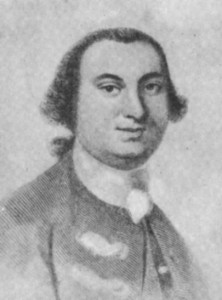Col. Henry Bouquet will be most often remembered for his brilliant defeat of the Shawnees, Delawares, Mingos, and Huron tribes at the Battle of Bushy Run on August 5th and 6th 1763. This battle lifted the siege of Fort Pitt and changed the course of that war. The climax of this battle was a charge of the 42nd of Foot the Royal Highland Regiment with broad swords that carried the field.
Bouquet was born in Rolle, Switzerland in 1719. He began his military career at the age of 17. As a professional soldier he was in the Dutch, Sardinian and Swiss Army before joining the British Army in 1756. He was placed with the 60th of Foot (The Royal American Regiment). Bouquet’s tactics, training and field management of troops would become universal tactics in the British Army more than a hundred years later. The Royal American unit was devised to be better suited for the type of guerilla warfare tactics of the American frontier wilderness than a standard infantry regiment.
Bouquet accompanied General Forbes in his expedition to Fort Duquesne in 1756 during the French and Indian War. As part of this attack on the French, Bouquet was surprised by French troops and their Indian allies near Loyalhanna Creek in present day Westmoreland County. He repulsed the attack and moved on to Fort Duquesne only to find the French had destroyed the fort. Bouquet built a new fort on the site and named it Fort Pitt after the prime minister.
Bouquet was considered a good officer; however, in history he will share a certain amount of villainy for his role with Jefferey Amherst, the commanding General of British military forces. During the siege of Fort Pitt the idea was raised of infecting the Indians with small pox by giving them blankets from the fort’s smallpox hospital. William Trent’s journal entry from May 24th, 1763 described this event though some historians do not believe it to be true. Shortly after this event was alleged to have happened there was an out break of small pox among the Indian tribes.
In October of 1764 Bouquet led a force of 1500 men into Ohio country to bring Pontiacs War to a close. This treaty which Bouquet negotiated set in motion his connection to Smith’s Rebellion. It was this peace treaty that included the exchange of all white captives held by the Indians. Because the Indians were unble to return all white captives until the spring of 1765 the Indian Trade Act of 1763 was still in effect.
To aid in these negotiations Bouquet issued a military pass to George Croghan to purchase and deliver trade goods from Philadelphia to Fort Pitt. This was the same pass that Croghan used to conceal his own illegal trade goods. The 81 pack horse train that was attacked at Sideling Hill on March 6, 1765 set in motion Smith’s Rebellion over the next nine months.
After this event Bouquet acted only as an information conduit between Fort Loudoun and General Gage, the commanding general of all of Britain’s military forces in America. Bouquet died suddenly on September 2, 1765 of what was presumed to be yellow fever. He had been promoted to general of British forces in the southern colonies and was in Pensacola, Florida at the time of his death.
Sources:
Henry Bouquet from Wikipedia – http://en.wikipedia.org/wiki/Henry_Bouquet
Col. Henry Bouquet and his Campaigns. Cyrus Cort. Westmoreland Co. Pennsylvania Bouquet Memorial Committee 1883
History of Col. Henry Bouquet and the History of the Western Frontier of Pennsylvania 1747-1764. Mary Carson Darlington 1915
William Trent’s Journal at Fort Pitt edited by A.T. Volwiler (1922) May 24th, 1763
